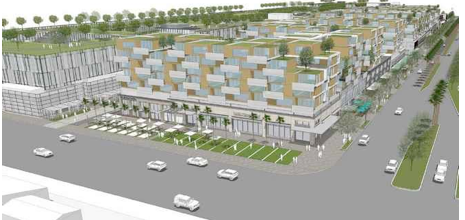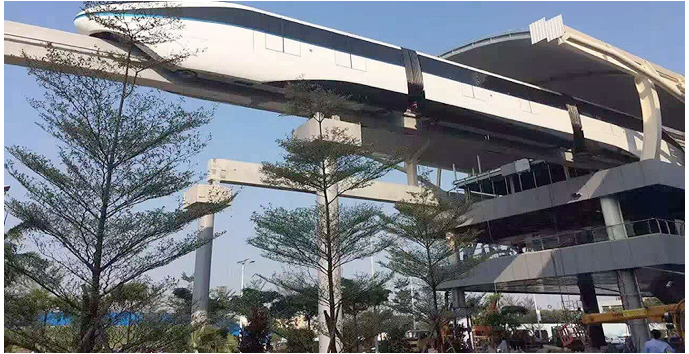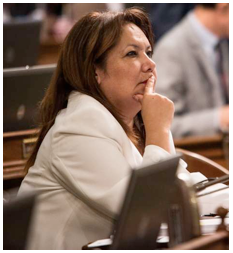Alert! Mega-Housing Developers Honing in on the City of Hawthorne
HAWTHORNE INSIDER-On November 8, residents in the City of Hawthorne will not only vote for their next President, they will also have an opportunity to voice their opposition to the mega-housing developers seeking to redevelop their community. The City Council will hold a Public Hearing at City Hall on Ordinance 2128 which seeks to increase the minimum lot acreage for high-density, mixed-use residential and commercial developments.
In early 2016, the Hawthorne City Council adopted the Downtown Hawthorne Specific Plan. Residents rejoiced as it appeared that the decades-old defunct Hawthorne Mall would finally see development. The plan put forth by the Charles Company, the company working with land owner Arman Gabay, includes 600 planned rental units at the mall. (Photo above.) Many residents of the community currently oppose any housing at the Hawthorne Mall site.
There are an additional several hundred housing units planned on the South Bay Ford site, further south down Hawthorne Boulevard. Two large-scale developments have surfaced in Hawthorne’s poorest neighborhood, Moneta Gardens. According to Councilwoman Angie English-Reyes, these were state mandated units. It is unclear if she is indicating that the Planning Commission and City Council had no option but to allow these developments.
Residents from all communities in Hawthorne have come out en masse to oppose high-density housing projects. Overwhelmingly, residents support the Hawthorne Downtown Specific Plan which allows for a variety of housing and commercial development along the Boulevard. With the current changes made by Ordinance 2128, the minimum project size of any other project would be three acres, translating to a minimum of 135 units. This directly contradicts what so many residents have been advocating since the possibility of development arose.
According to municipal code in the City of Carson, developers can “jump the block” and use lots that are separated by public streets to meet their site size requirement. Hawthorne’s Interim Planning Director and consultant, John Ramirez, says, “This is the intent of the changes made to Hawthorne’s zoning.” They are encouraging developers to acquire smaller parcels along the Boulevard to get the amenities of larger complexes.
Unfortunately, that puts dozens of small businesses in jeopardy. Ramirez has suggested that these small land/business owners can sell out to big developers and then move back into the revitalized projects. What he fails to mention is the triple increase in rents by the developers, forcing several small businesses out of town -- or worse, out of business.
The current Ordinance 2128 also increases the size requirement of living space in mixed use and single family zones, encouraging larger floorplans in each unit. This drives up the cost for builders to develop and thus, the monthly rent/purchase price on the units also increases.
“We estimate costs based on square footage. At $2.50 per square foot, we will be renting a two bedroom 1,200 square foot apartment for close to $3,000 per month,” says Bill Hassan, owner of KIG Properties LLC.
By creating larger spaces at a higher cost, this Ordinance 2128 increases the potential for multiple families to cohabitate and overcrowd. These living arrangements increase car congestion, demand on utilities and public resources like police, fire and schools.
The Hawthorne Police Chief, Robert Fager, has given two presentations on the hiring needs of his department in recent council meetings. It has also been made public through the Civil Commission that there is a lack of applicants for open positions in the Police Department. Additionally, close to 1/3 of the active duty Hawthorne police officers are set to retire in the next 5 years. There is a serious, inherently critical shortage of police officers to meet the demands of large units over three acres.
The City of Hawthorne also faces a huge parking crisis today. Because of poor planning in the 1960s-1980s, there are several smaller units all over the city that are not meeting the demands of modern living. For example, in the Ramona tract there are dozens of 2-4 unit buildings that are only required to have one space per unit no matter how many bedrooms the units have. Thus, a fourplex with 2-bedroom units is only required to offer four parking spaces despite most two-adult households having two cars each. That places a demand on the city to accommodate four additional cars for just one building. There are 1,035 apartment buildings in Hawthorne today.
The zone text amendment approved by the Planning Commission 2016ZA12, which led to Ordinance 2128, seeks to increase this to one guest parking space for every two units -- a 33% increase in the guest parking space requirement. This places an economic burden on developers, causing them to reduce the number of living spaces in favor of parking spaces and does nothing to solve the current parking crisis.
Small to medium-sized mixed use development allows for a variety of home types to be constructed. The most vital of these smaller units are live/work spaces. As the City of Hawthorne’s Senior Planner, Chris Palmer suggested in his presentation at the October 19 Planning Commission Meeting that there are a variety of design options and industry choices that would be constructed in these smaller developments for tenants from artists to technology startups.
Liza Simone of Phantom Galleries LA has successfully created Gallery Row in Downtown Los Angeles. As a result, this living style has spurred a micro-economy of entrepreneurs who have both space to create and produce their own income.
At a minimum of three acres, developers cannot economically build live/work units. The commercial space would be developed into large, high-profile retail and office space. These companies have a well-documented history of paying minimum wages and not offering room for professional advancement.
Additionally, by effectively stopping smaller projects from being constructed, thousands of construction jobs are lost. Dozens of professional contractors, their sub-contractors, material suppliers and laborers are without potential work, which pays at least triple minimum wage.
Finally, these changes affect local builders who have been working with the city for decades to acquire land, work with zone changes and spend their time and money to create projects for resident’s approval. The current message that the Planning Commission is putting out to potential investors is that the rules can change at any time. This does not create a certainty that developers need to build. And our goal is to enhance economic development, not stifle it.
Hawthorne has a history of pay-to-play politics. The Mayor’s office has been rocked with scandal, as two of the last three mayors were indicted on felony charges and the last mayor was evicted by two separate landlords. The corruption in local government has been attributed to wealthy land developers influencing elections with hefty campaign donations in exchange for political favors on their projects.
Mayor Alex Vargas promised an end to the pay-to-play corruption, while he touted the benefits of the Hawthorne Blvd. Specific Plan; however, recent introduction of Ordinance 2128 places the burden of mega-housing projects squarely on his shoulders. By crippling small- to medium-sized developments, Mayor Vargas is ushering in a new and deafening thunder of massive housing development in Hawthorne.
Public Hearing on Ordinance 2128 will be held at Hawthorne City Hall on November 8, 2016 at 6pm.
(Amie Shepard is a local realtor and activist. She currently serves on the Board of the Hawthorne Economic Development Council and is Vice President of the Ramona Neighborhood Association. She was a candidate for Hawthorne City Council in 2015.) Prepped for CityWatch by Linda Abrams.






 Had the PLUM Committee considered the Historic-Cultural Monument status motion before the 8150 building motion, they would have had to seriously deal with the question of what to do about the Lytton Savings Bank building (photo left). Instead, they postponed consideration of Lytton Savings Bank’s Historic-Cultural Monument status until November 22. That’s well after next week’s November 1 City Council vote on approving the 8150 Sunset project.
Had the PLUM Committee considered the Historic-Cultural Monument status motion before the 8150 building motion, they would have had to seriously deal with the question of what to do about the Lytton Savings Bank building (photo left). Instead, they postponed consideration of Lytton Savings Bank’s Historic-Cultural Monument status until November 22. That’s well after next week’s November 1 City Council vote on approving the 8150 Sunset project. 

 Aside from noise, difficulties backing out of driveways, lack of parking or inadequate access for emergency vehicles – concerns which can be mostly overlooked if they occurred a couple of times per year – the conversion of a residential street for commercial use on a semi-regular frequency is contrary to the right to enjoy one’s property.
Aside from noise, difficulties backing out of driveways, lack of parking or inadequate access for emergency vehicles – concerns which can be mostly overlooked if they occurred a couple of times per year – the conversion of a residential street for commercial use on a semi-regular frequency is contrary to the right to enjoy one’s property.




 In my opinion it is because she is at every event in her district. She knows her communities and fights for them. One recent success was her spear heading efforts, along with other organizations in the community. to open a satellite branch of Mission Hills College in Sunland. They broke ground last month.
In my opinion it is because she is at every event in her district. She knows her communities and fights for them. One recent success was her spear heading efforts, along with other organizations in the community. to open a satellite branch of Mission Hills College in Sunland. They broke ground last month. 
 Atake’s point shines a glaring light on the comprehensive lack of prior humane experience by virtually all of Garcetti’s current shelter Commissioners:
Atake’s point shines a glaring light on the comprehensive lack of prior humane experience by virtually all of Garcetti’s current shelter Commissioners: 








 One consequence of this convoluted planning process is that the city’s public infrastructure and services -- like the football stadium in our analogy -- are ignored. The Department of City Planning defines their day-to-day planning mission as the efficient processing of developers’ requests for discretionary actions. It is not comprehensive, rigorously monitored planning, but what the executive suite calls the “development process,” and what they publicly define as promoting foreign and domestic
One consequence of this convoluted planning process is that the city’s public infrastructure and services -- like the football stadium in our analogy -- are ignored. The Department of City Planning defines their day-to-day planning mission as the efficient processing of developers’ requests for discretionary actions. It is not comprehensive, rigorously monitored planning, but what the executive suite calls the “development process,” and what they publicly define as promoting foreign and domestic 











